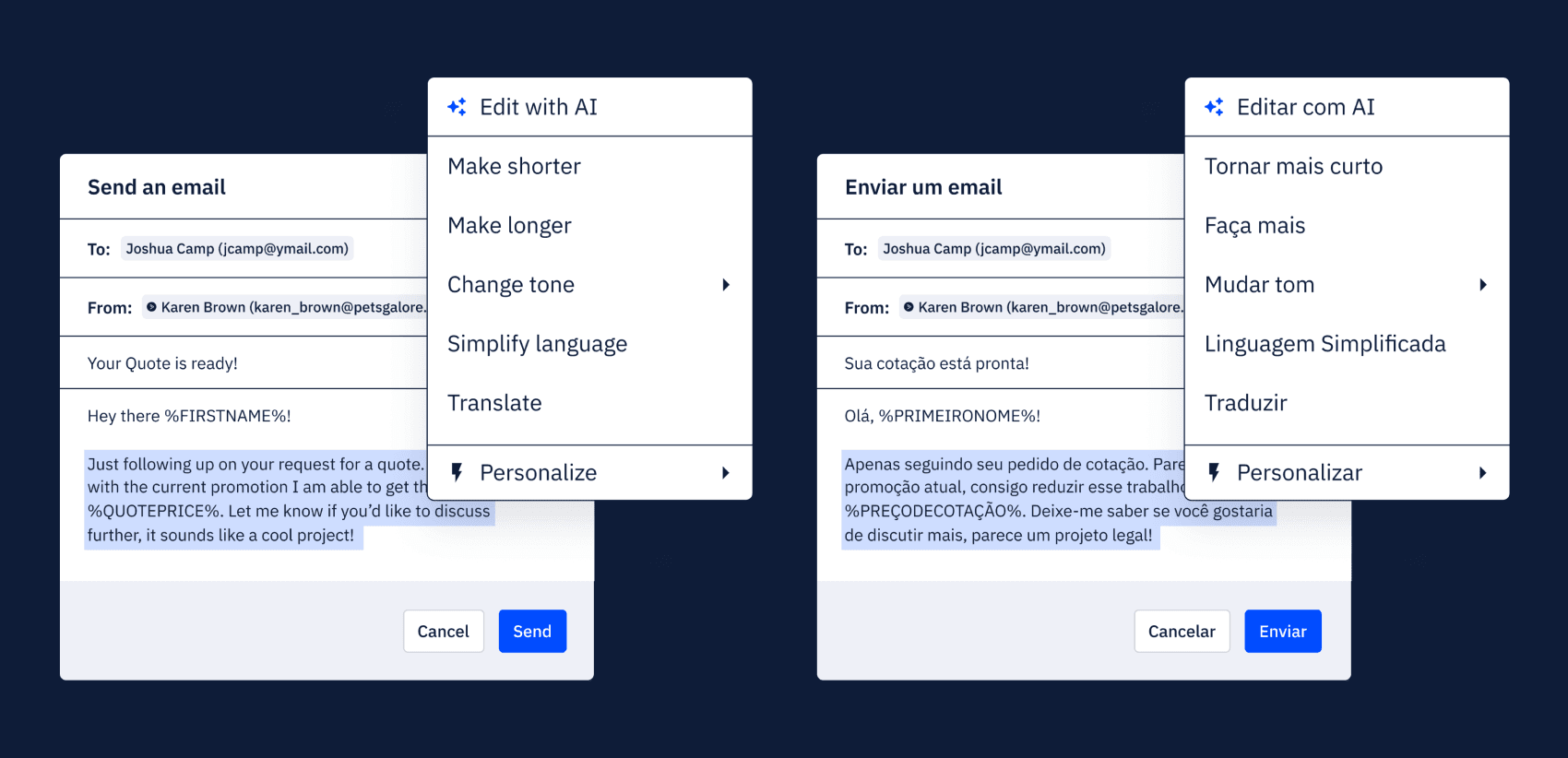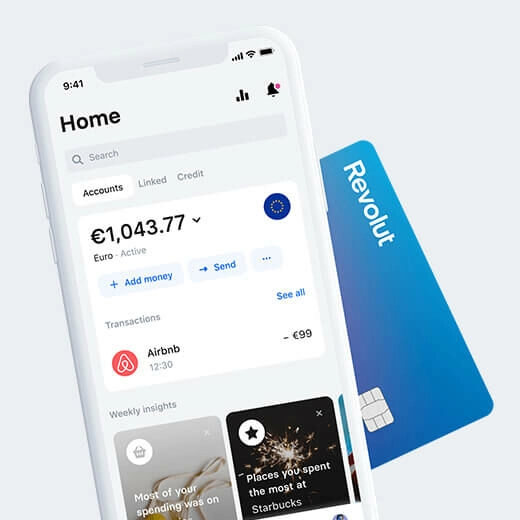How ActiveCampaign saves 16% on translations and launches localized campaigns in just 2 days
“If we need to launch a site page and it needs to be done extremely quickly it could take just two days and that includes going through Lokalise, through our vendor, maybe a quick internal review, and then publishing.”
Niamh Scallan,
Senior Localization Specialist at ActiveCampaign
Numbers
- 16% savings in one year using translation memory
- 73% increase in traffic to the Spanish blog YoY
- 111% increase in visitors to localized Help Center articles in two years
- 2 days to launch localized email sequences
About
ActiveCampaign helps small teams power big businesses through intelligent marketing automation. ActiveCampaign customers from over 170 countries can create custom automations with their favourite integrations to power personalized marketing, transactional emails, and one-to-one CRM interactions throughout the customer lifecycle.
TLDR
Before a localization team was introduced at ActiveCampaign, localization was handled by the Engineering team. Developers used machine translation without human checks and there was no formal localization process. Frustrated by inefficient localization workflows, the team chose Lokalise for its integrations, customer support, and transparent pricing. Now, Niamh and Jonathan, Sr. Localization Engineer, manage the localization program, and many stakeholders collaborate inside Lokalise. ActiveCampaign's team can now launch a localized marketing campaign in just two days and save 16% on translation costs every year.

A large number of ActiveCampaign’s customers are based outside of the US, so the team wanted to localize their product and marketing materials to provide a high-quality end-user experience for global customers.
No single source of truth for localization. No alignment with go-to-market teams.
Before a Localization team was introduced at ActiveCampaign, localization was handled by the Engineering team.
Developers translated product strings using machine translation and saved them in an outdated translation management system. They were not checked by humans, there was no linguistic quality assurance, no glossary, and no translation memory.
“Engineers were tinkering with internationalization, but there wasn't any formal process,”
From inefficient localization processes to automated workflows
Frustrated with the inefficient processes, the team started to look for a translation management system and landed on Lokalise.
ActiveCampaign chose Lokalise as its localization partner for three reasons
- “Definitely for the Integrations.” Lokalise had all the integrations the team already worked with, including Figma, Zendesk Guides for help center articles, GitLab for product translations, and WordPress. They wanted to pull the strings in from those Integrations in an easy way and not have to worry about a super manual, complex, and time-consuming process.
- Customer support. ActiveCampaign has built a great relationship with its dedicated Lokalise Customer Success Manager over time, so there was a great level of trust.
- The transparency around pricing. It was very clear how much they’d have to pay, which was also appealing to the leadership team. When looking into other translation management systems, there were often hidden costs for going over certain thresholds or adding an extra integration down the line.

A localization team that works better together
Now, Niamh works alongside Jonathan Tyrrell, Sr. Localization Engineer at ActiveCampaign, to manage the localization program, and various teams come together in Lokalise to work on a wide range of localization tasks:
- The localization engineer connects localization workflows through Integrations and fixes complex bugs
- A localization manager (Niamh) manages the projects and stakeholders, working closely with vendors and internal stakeholders
- Three to four internal reviewers from the customer org, with Lokalise seats, review high-priority help center documentation and edit translations directly inside Lokalise without their translations being overwritten.
- Language vendors also work inside Lokalise and are able to leverage the CAT features and glossary
- Other engineers also have access to Lokalise so they can download translations if they need to
- Senior Content Marketing Specialist, who reviews content within Lokalise.
“The translation history feature is super helpful, enabling me to review, perform quality assurance, and compare versions with ease. Additionally, I find the Lokalise AI feature quite useful for accelerating the workflow, especially when we face tight deadlines.”
Marina Casaril, Senior Content Marketing Specialist
Bilingual team members from the customer organization occasionally help review translated help center documents, even though localization isn’t necessarily part of their job. Niamh says she hasn’t encountered any pushback here because they want to help create better customer experiences.
“People who are willing to help are customer-facing or they're on the education team. So even though it's not directly part of their role, they're keen to improve customer resources. So usually there’s buy-in where they know that giving some of their time means customers will have higher quality translations available to them via our help center documentation.”
The result: 2 days to localize marketing campaigns and AI translation for faster product launches
It doesn’t take long for the team at ActiveCampaign to launch a new localized marketing campaign.
“It could take just two days and that includes going through Lokalise, through our vendor, maybe a quick internal review, and then publishing,” she says.
To save on translation costs, the team uses translation memories.
They’re separated for different content types (e.g. Product, Marketing, Help Center) and translation methods (Human vs. fully MT workflow) to maintain the right style and tone of voice for each content type. So far, they’ve seen 16% savings in one year using translation memory.
Meanwhile, glossaries are continuously updated with ActiveCampaign-specific terminology to ensure all content is aligned.
The team also uses Lokalise AI for individual product strings.
“If we're in a bit of a bind and we need something launched really quickly, we’ll use Lokalise AI for that and replace with human translations later if needed.”
It’s not just time they save. They can also avoid minimum charges for small numbers of translated strings. Instead, they translate those strings with Lokalise AI and can wait until more content is available for translation to make a larger request to their vendor.
ActiveCampaign currently localizes their go-to-market and product content into:
- 5 languages: website, help center guides, emails, and other marketing materials
- 14 languages: product
- File formats used: xliff exports for the website, HTML files for email campaigns, and JSON for product strings
Three top features for Localization Project Managers
Niamh loves how Lokalise integrates with the tools she and her team already use, as well as how well they work.
“I feel like every single one of them [integrations] is very seamless and it would be so painful if we have to localize without them and do any sort of manual extraction of the strings.”
The second feature that stands out is Lokalise’s UI.
“It's really pleasant to use and very clear. It's very aesthetically pleasing if that makes sense and so that definitely jumps out in comparison to a lot of other TMSs”
“And also support! Anytime. I've reached out to support via chat they're super helpful and really knowledgeable.”
How ActiveCampaign measures the impact of localization
Niamh sits within the Content Marketing team and reports into Demand Gen. So one of the key metrics they’re interested in tracking is the cost of translation vs the return on investment.
“For example with an email campaign, we'll look at how much it cost us to localize it versus the volume of new business or expansion that it led to so that's one key metric”
They also look at the performance of localized blogs, which is harder to calculate because it takes time for blogs to rank.
Since they started optimizing and localizing new content for their Spanish blog, the team has seen a 73% increase in traffic YoY (May 2023 vs. May 2024).
Another metric they track is the volume of traffic to their localized help center documentation.
“We try to keep an eye on that and see if it's increasing or decreasing how much are customers using it.”
Finally, they also pull numbers on the volume of non-english speakers using their product.
“That's been increasing year on year for a number of years.”
For Niamh, it’s essential to track these KPIs and business outcomes. This way she can learn which types of content perform well and adjust the localization strategy for different markets and languages.
Read more case studies

How Lokalise contributed to Revolut's massive growth

ESL Gaming shortens time to market with a centralized approach to translation

How Arduino localizes its edtech products and makes developers happier
Case studies

Behind the scenes of localization with one of Europe’s leading digital health providers
Read more Case studies
Support
Company
Localization workflow for your web and mobile apps, games and digital content.
©2017-2025
All Rights Reserved.

